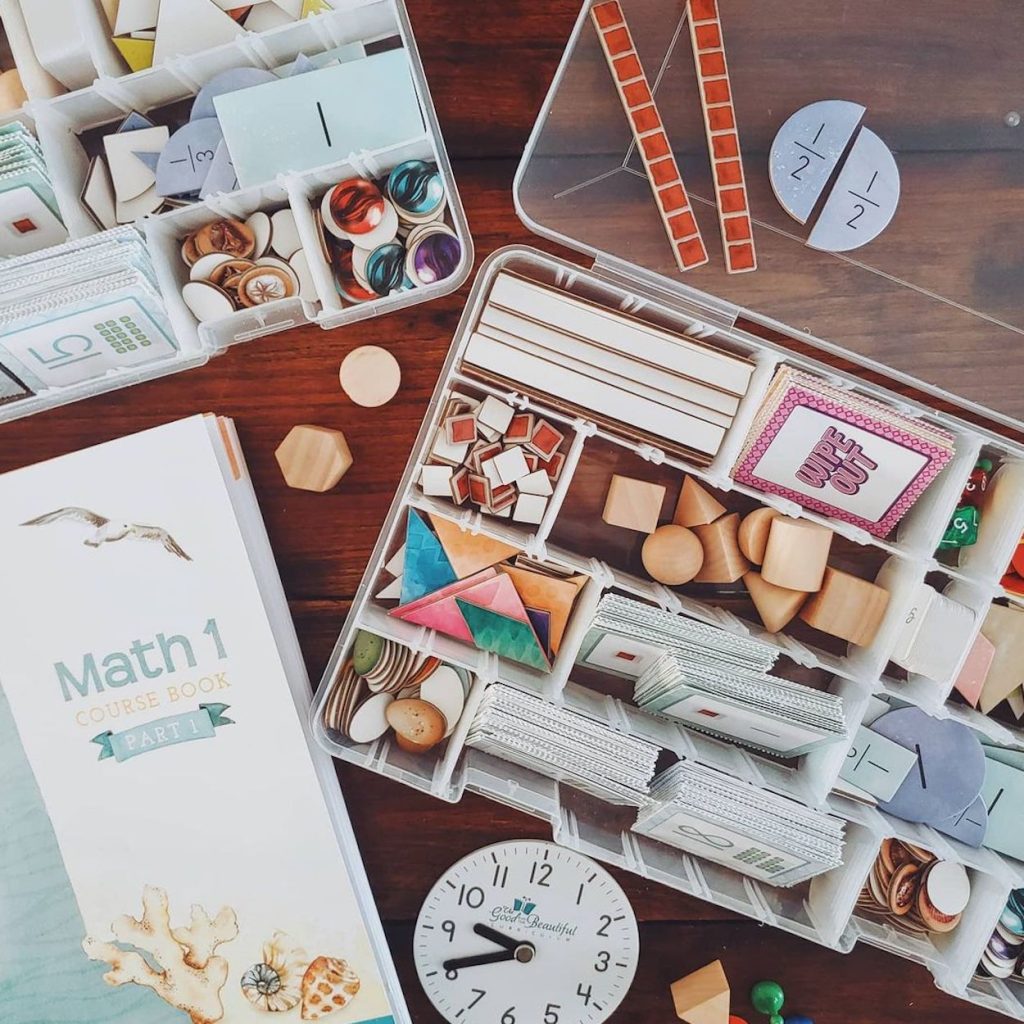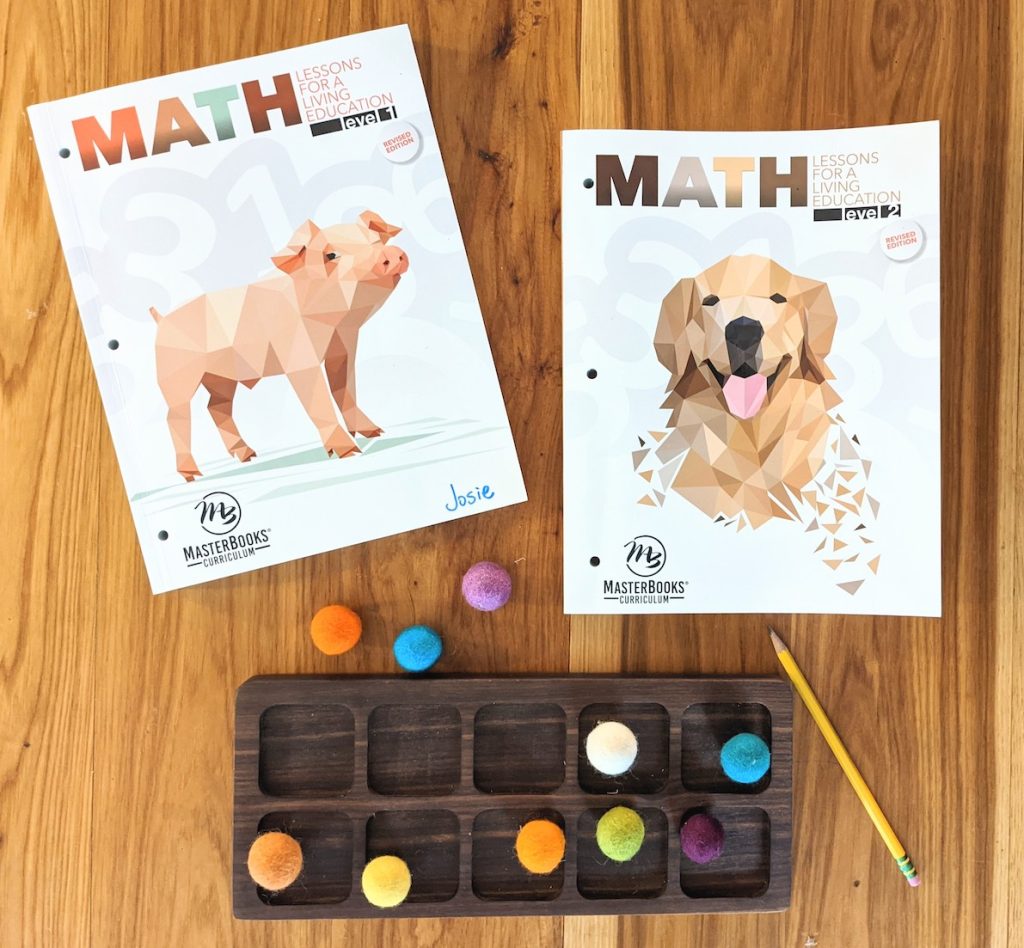When we started our homeschool journey I knew that math would be an area of struggle for me, simply because it’s not my personal favorite subject. Over the years we have tried several different math curricula, and many of them were a good fit for my family at different stages.
This blog post details my experience using The Good and the Beautiful when my children were young, and the other curricula we tried when we transitioned to something they could work through more independently.
In more recent years, my older two children have switched to Teaching Textbooks, a digital math curriculum. For more details about my experience with Teaching Textbooks, read my full curriculum review.
In this blog post:
- The Good and the Beautiful curriculum review
- Masterbooks: Math Lessons for a Living Education curriculum review
- Resetting with math games
- Math-U-See curriculum review
- Favorite homeschool resources from Treehouse Schoolhouse
The Good and the Beautiful curriculum review

The first formal math curriculum I ever purchased was The Good and the Beautiful Math K. At that time my children were ages 5 and 6. It was primarily for my 6-year-old, but my younger daughter joined in on some games when she wanted to. At that time, school was very casual and we had a lot of time to play games, work with manipulatives, and do lessons. Our days were wide-open and long lessons where I needed to be totally hands-on were more manageable. The Good and the Beautiful was a great fit for us at that time. We would spend 30-45 minutes each day on math and it was enjoyable and effective.
The following year we continued with The Good and the Beautiful Math 1. A few weeks in and I knew we needed a change. I needed something more “open-and-go” with shorter lessons and with the option for my children to work more independently. Lessons weren’t getting done and the kids’ understanding of the material was waning. At this point, we had added many other subjects into our day and could no longer fit it all in.
We also now had two little ones in tow to keep safe and cared for.
That being said, I have since heard that The Good and the Beautiful has since simplified their curriculum and their updates are loved by many. I have not personally used the newest version, but if we found ourselves searching again, I wouldn’t hesitate to give it a try.
Check out the revised versions of The Good and the Beautiful Math here.
The Good and the Beautiful takeaway

I don’t regret usingThe Good and the Beautiful for the season we were in. We all enjoyed it. It was such an elaborate, fun, and engaging math curriculum for young learners. I think it was a great fit for the earliest year of our formal schooling when we had the time and space in our days to use it. They have since revised the curriculum to seemingly solve some of the issues we personally had with it and I would still recommend the curriculum as a solid choice.
Masterbooks: Math Lessons for a Living Education curriculum review

After using The Good and the Beautiful, we switched to Masterbooks: Math Lessons for a Living Education when my children were at 1st and 2nd grade levels. I did so much research and wrote this blog post right when we began on the reasons I chose it. I really thought it would be a good fit for us and it just wasn’t.
The curriculum uses one long storyline weaved throughout all of the levels. My children love stories, so I thought that alone would draw them in. I also loved that it was more hands-off. It was a huge change fromThe Good and the Beautiful because it was strictly workbooks. My children weren’t opposed to that, but a happy medium would have been better. There were some recommendations for manipulatives using household materials for some of the lessons, but for the most part it was story- and worksheet-based.
Unfortunately, the storylines did not hold my children’s attention and they wanted to skip the stories altogether. If they did so, much of the actual teaching of the math concepts were also being skipped. I also didn’t love the way place value was taught in this curriculum. The kids were beginning to gain understanding of it, but to me, it could have been presented in a more straight-forward way. One of the activities that the children were asked to do on a continual basis was to make flashcards of the basic math facts with a storyline attached to them. We attempted this at first but it seemed awkward and my kids weren’t into it. We all began to dread math lessons for all of these reasons.
We stuck it out for a while, but I realized my almost-3rd grade son had almost zero confidence in recalling his math facts (addition or subtraction) and my 1st grade daughter started saying she hated math.
Masterbooks takeaway
I know many families that use and love this curriculum, but for multiple reasons it wasn’t a good fit for me or my children. I did not see their math skills develop when we used this curriculum. If we would have done all of the lessons as instructed (including all of the stories and flashcards), we may have had a better outcome academically. I personally would not recommend this math curriculum.
Resetting with math games
We took a math break for a while after that and simply played math games while I researched for what to do next.
Here are a few of our favorite math games:
Math-U-See curriculum review

Next we moved to Math-U-See. I chose it because it was recommended by a few experienced homeschool mamas and by graduated homeschool students I highly respect. What really pushed me over the edge was when I discovered that they had an accelerated program to focus on mastery of the addition and subtraction facts (the exact area of weakness I was seeing in my son). I started with that program to see if it would be a good fit for the long haul.
Here is how Math-U-See describes it: “Accelerated Individualized Mastery (AIM) provides a new solution for struggling math students with gaps in their foundational math skills set. The AIM programs use proven Math-U-See strategies and manipulatives in combination with an accelerated approach to help students successfully master math facts.”
See more about Math U See AIM program here.
We began using the AIM program and I saw how brilliantly designed the curriculum was. It really clicked for both myself and my son. We worked hard on mastering his addition facts with the AIM program and succeeded in about a month.
At that point I went ahead and decided to purchase the DVDs, manipulatives, and math books for both of my children and we have been all enjoying it now for several months. I see both of my children gaining joy, skills, and confidence in math!
Here is what I love about Math-U-See:
- Someone else is teaching the concept: Yes, I said it. I love that Mr. Demme (a sweet and funny homeschool dad and math genius) is teaching my children the lessons. I sit in on the presentation while my child is watching (5 – 20 minutes, depending on the lesson), and then I have had first-hand experience on how to reteach the lesson if they need more explanation.
- It is mastery-based: This means the children don’t move on until they have mastered a skill. After they have watched the lesson and then narrated it to me (taught me what they learned), the child works out problems according to that lesson for as long as they need until mastered. This is usually a few days- a week for us.
- It is cumulative: This means that while it’s teaching only one new skill at a time…and continuing with THAT skill until it’s mastered, it also reviews past skills. Each week they review bits of everything they have learned in past lessons.
- It grows with my children: Not all math curriculums go all the way through high school, but this one does. I can’t say for sure, but I could see us using it for the long haul.
Math-U-See Takeaway
I highly recommend Math-U-See and wish we would’ve started sooner! It has given me confidence as the teacher and has given my children joy and confidence as students.
Favorite homeschool resources from Treehouse Schoolhouse
Wonder of Nature Number Bundle

The Wonder of Nature Number Bundle is designed to offer young children a multi-sensory invitation to recognizing, forming, and writing numbers and developing basic number sense. Slide these sheets into a restaurant menu cover or dry-erase pouch so your child can practice them again and again. Use dry-erase markers and wipe clean after each use.
The Wonder of Nature Number Bundle also includes Number Cards. These cards are designed to aid in developing number sense and a foundation leading to a strong understanding of math skills. These cards are a tool to gently invite your children into hands-on mathematical learning. The watercolor illustrations that coordinate with each number can provide a representation of mathematical ideas, displaying a corresponding number of illustrations with each number.
Homeschool Planner

Track all of your homeschool curriculum with ease using the Homeschool Planner. I developed this homeschool planner to meet my needs as a busy homeschool mom of multiple children. I wanted something simple and beautiful. Customized for Morning Time, Daily Rhythm, and lesson planning, this planner has helped many homeschool moms around the world make space for more beauty and joy in their homeschool. The planner is available as both a spiral-bound hard copy as well as a digital, editable version.
I hope these reviews are helpful to you! Let me know your favorites for math in the comments below.
Disclaimer: Treehouse Schoolhouse is not partnered with any of these companies and all opinions are based on my personal thoughts and experience. Every family and child is unique and may connect with a curriculum that was not a good fit for us. This is simply our path and experience.




![Winter Solstice Activity for Kids [Free Worksheet PDF]](https://storage.googleapis.com/treehouse-schoolhouse-media-dev/fe547f4b-gn4a7877-scaled.jpg)